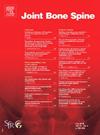Diagnostic accuracy and trajectories of referrals for gout to rheumatology
IF 3.8
3区 医学
Q1 RHEUMATOLOGY
引用次数: 0
Abstract
Objectives
To evaluate diagnostic accuracy and trajectories of gout referrals to rheumatology including factors associated with an accurate diagnosis.
Methods
We performed a retrospective cohort study of referrals at 4 rheumatology clinics in Brampton, Canada from December 2019 to January 2023. We assessed gout diagnostic accuracy referenced to the rheumatologist's “gold standard” diagnosis, describing alternative final diagnoses. Using multivariable logistic regression, we identified factors associated with an accurate gout diagnosis.
Results
Among 4315 patients, 216 were diagnosed with gout. Of 191 gout referrals (mean (SD) age 58.4 (15.4) years; 77.0% male), the diagnosis was unchanged in 159 (83.2%) patients with alternative diagnoses comprising osteoarthritis, autoimmune inflammatory arthritis and calcium pyrophosphate deposition disease. Referring physicians had moderate-to-high sensitivity (73.6%, 95% CI: 67.2–79.4), specificity (99.2%, 95% CI: 98.9–99.5), positive predictive value (83.2%, 95% CI: 77.2–88.2), negative predictive value (98.6%, 95% CI: 98.2–99.0) and inter-rater reliability (Cohen's kappa: 0.77, 95% CI: 0.72–0.82). Accuracy was highest amongst internists and emergency room physicians. Male sex (OR 14.32, 95% CI: 4.44–46.17), serum urate ≥ 500 μmol/L (OR 9.10, 95% CI: 2.19–7.78), lower extremity monoarthritis (OR 5.08, 95% CI: 1.59–16.27) and symptom duration ≤ 2 weeks (OR 3.87, 95% CI 1.23–12.21) were predictive of a final gout diagnosis.
Conclusions
Referring providers had reasonably high accuracy in diagnosing gout. Traditional risk factors were associated with concordance with the consultant rheumatologist. Suboptimal gout care likely does not stem at point-of-diagnosis and quality improvement efforts should be focused on mitigating treatment-associated care gaps.
痛风转诊到风湿病学的诊断准确性和轨迹。
目的:评估痛风转诊到风湿病学的诊断准确性和轨迹,包括与准确诊断相关的因素。方法:我们对2019年12月至2023年1月加拿大Brampton的4家风湿病诊所的转诊患者进行了回顾性队列研究。我们评估痛风诊断的准确性参考风湿病学家的“金标准”诊断,描述替代的最终诊断。使用多变量逻辑回归,我们确定了与准确的痛风诊断相关的因素。结果:4315例患者中,216例诊断为痛风。191例痛风转诊(平均(SD)年龄58.4(15.4)岁;77.0%男性),159例(83.2%)患者的诊断不变,其他诊断包括骨关节炎、自身免疫性炎症性关节炎和焦磷酸钙沉积病。转诊医师具有中高敏感性(73.6%,95% CI: 67.2-79.4)、特异性(99.2%,95% CI: 98.9-99.5)、阳性预测值(83.2%,95% CI: 77.2-88.2)、阴性预测值(98.6%,95% CI: 98.2-99.0)和评估间信度(Cohen’s kappa: 0.77, 95% CI: 0.72-0.82)。准确度最高的是内科医生和急诊室医生。男性(OR 14.32, 95% CI: 4.44-46.17)、血清尿酸≥500µmol/L (OR 9.10, 95% CI: 2.19-7.78)、下肢单关节炎(OR 5.08, 95% CI: 1.59-16.27)和症状持续时间≤2周(OR 3.87, 95% CI: 1.23-12.21)是最终痛风诊断的预测因素。结论:转诊医师对痛风的诊断具有较高的准确率。传统的危险因素与风湿病专家咨询意见的一致性有关。次优痛风护理可能不会在诊断点停止,质量改进工作应侧重于减轻与治疗相关的护理差距。
本文章由计算机程序翻译,如有差异,请以英文原文为准。
求助全文
约1分钟内获得全文
求助全文
来源期刊

Joint Bone Spine
医学-风湿病学
CiteScore
4.50
自引率
11.90%
发文量
184
审稿时长
25 days
期刊介绍:
Bimonthly e-only international journal, Joint Bone Spine publishes in English original research articles and all the latest advances that deal with disorders affecting the joints, bones, and spine and, more generally, the entire field of rheumatology.
All submitted manuscripts to the journal are subjected to rigorous peer review by international experts: under no circumstances does the journal guarantee publication before the editorial board makes its final decision. (Surgical techniques and work focusing specifically on orthopedic surgery are not within the scope of the journal.)Joint Bone Spine is indexed in the main international databases and is accessible worldwide through the ScienceDirect and ClinicalKey platforms.
 求助内容:
求助内容: 应助结果提醒方式:
应助结果提醒方式:


